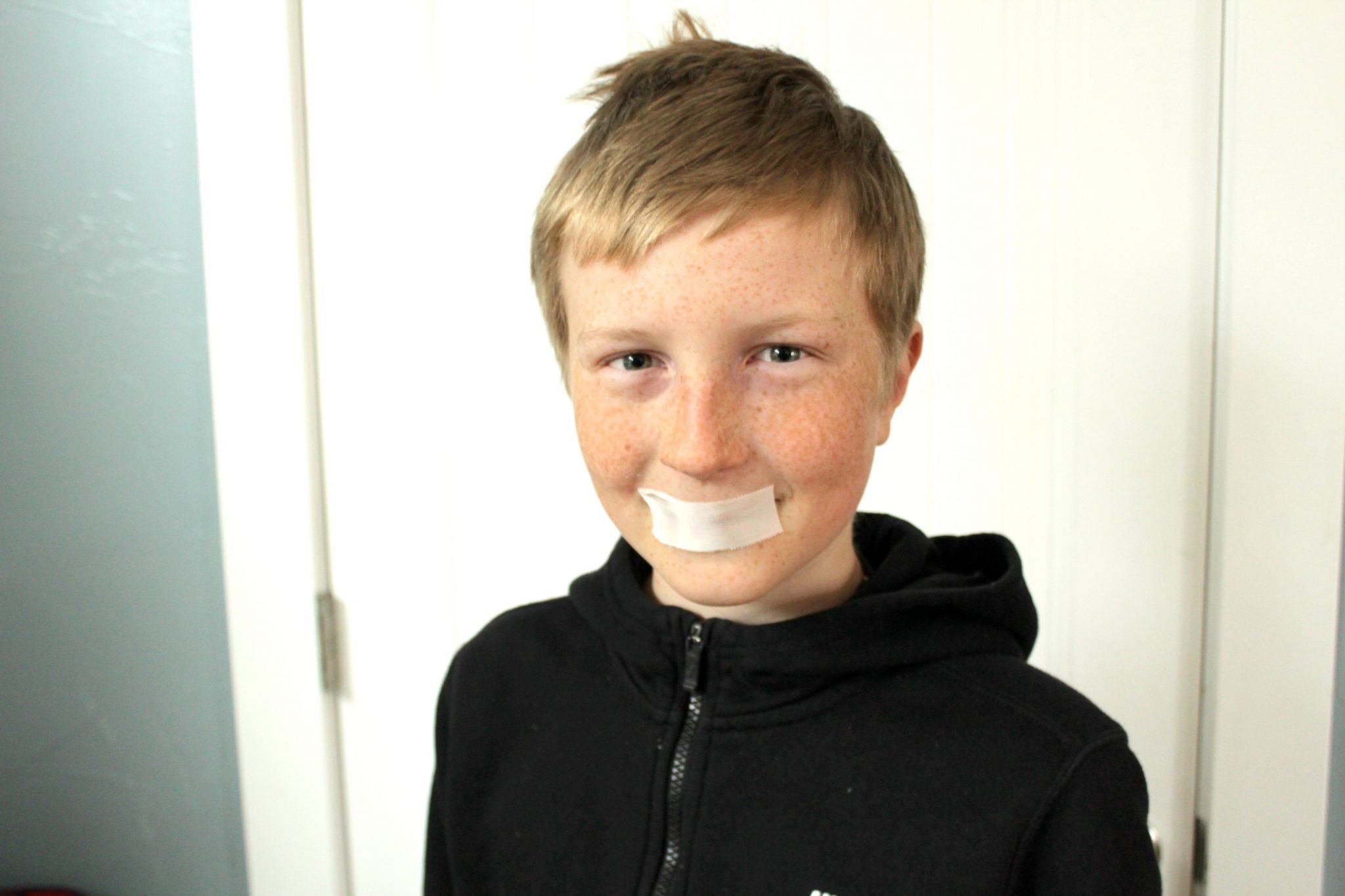
What would you think if I told you that braces, asthma medication, decongestants, ADHD medications, and even CPAP machines could be replaced by a simple $2 roll of tape?
No, it’s not actually the tape that’s solving the problems, it’s just training you into the habit of nose breathing and out of the habit of mouth breathing.
Nose breathing is our natural way of breathing, with mouth breathing being part of our emergency ‘fight or flight’ system. Mouth breathing even triggers a fight or flight response on its own. Our modern culture contributes to the mouth breathing habit in a few ways.
First, our culture is higher stress than that of our ancestors, and stress triggers mouth breathing. Inversely, mouth breathing also triggers a stress response, creating a loop. Second, low-grade inflammation, chemical irritants, and mild allergies often result in chronic plugged noses. And the owners of these plugged noses often get in the habit of mouth breathing to get the air in.
Once again, your body, when encouraged to work properly through diet and lifestyle changes, is very capable. Little changes in our lifestyle add up to big changes in our overall health. In this case, it’s that we are too often breathing through our mouths, especially during sleep.
Mouths are for talking and eating, noses are for breathing
When we breathe in and out through our nose, we are using the normal pathway for air. Irritants are caught immediately in our nose. The air is warmed in our nose before hitting our lungs.
Different parts of the brain are oxygenated in different concentrations with nose breathing. In contrast, mouth breathing encourages the high-anxiety fight-or-flight response and alters brain chemistry. (source)
Nitric oxide is produced in the body in the nasal sinuses, and is ‘activated’ by nasal breathing. Nitric oxide is important for everything from keeping airways open to cognitive function to tumor supression.
Tape to encourage nose breathing:
- Somnifix is specially designed for mouth taping, and it may be a good way to introduce yourself to tape the mouth. After using this hypoallergic strip, most of us long-term mouth tapers have chosen to use regular medical tape instead (below).
- 3M Micropore tape is widely recommended for its less-sticky adhesive that leaves little residue the next day. This tape works for many people, but some are allergic to the adhesive.
- Hypoallergenic silk tape is what we ended up using due to an allergy to the adhesive on the micropore tape.
Other ways to encourage nose breathing:
- Running a warm mist humidifier helps keep airways open.
- Practicing nose breathing and closed mouth posture (tongue resting on the top of the mouth) during the day.
- Mindfully practicing nose breathing during exercise.
- Keeping stress low to keep the body out of fight or flight response.
Mouth breathing is associated with:
- Cavities, due to dry mouth
- Narrow palate, requiring braces and/or removal of teeth (source, source)
- Change in facial development including a smaller chin (source)
- Poor quality sleep (including thrashing, snoring, and waking up grumpy)
- Attention deficit during the day (source)
- Allergic rhinitis (source)
- Thyroid and adrenal function, due to reduced nitric oxide (source)
- Increased stress response including the fight/flight response (source)
- Sensory processing issues, especially oral defensiveness
- Learning disabilities, due to poor quality sleep and lack of nitric oxide in the brain (source)
Is more oxygen always better?
Just like food and water, it is possible to get too much oxygen to different parts of the brain. In the case of mouth breathing, it is shown that breathing through the mouth over oxygenates the prefrontal cortex, which causes a ‘fatigue’.
The prefrontal cortex, which also is one of the main parts of the brain affected by alcohol (source), is responsible for such things as self control, emotional regulation, personality, and delayed gratification (source).
Our results suggest that continued oxygen load on the prefrontal cortex from mouth breathing during the waking hours is one possible cause of ADHD arising from central fatigue.
Nasal breathing increases Nitric Oxide
Nitric oxide is a vasodilator that is produced at least 10% more when we breathe through our noses.
The discovery within the paranasal sinuses for the production of nitric oxide (NO) has altered the traditional explanations of sinus physiology… healthy paranasal sinus epithelium expresses an inducible NO synthase that continuously generates large amounts of NO, a pluripotent gaseous messenger with potent vasodilating, and antimicrobial activity. (source)
Nitric oxide is important for pulmonary (lung) function, and not having enough of it is associated with cardiac problems, increased cancer risk and cancer progression, poor wound healing, asthma, and more (source).
Continuous and regulated generation of NO is essential for the health of the cardiovascular system, immune and nervous system. Decreased production and/or bioavailability of NO is recognized as being one of the earliest events in the onset and progression of many diseases. – Nitric oxide enhancement strategies
This paper discusses the necessity of nitric oxide in pulmonary function and how those who are intubated miss out on this important compound.
Dental and Orthodontia problems
As Dr. Weston Price found, good oral health (avoiding cavities and having straight teeth) is much more of a holistic problem than just genetics, brushing, flossing, and needing braces.
Dr Mark Burhenne, DDS, talks about mouth taping, mouth breathing, and its effects on oral health in this podcast.
“Mouth breathing changes the hemodynamics of blood flow in your body and brain. It causes dry mouth which can lead to more cavities, bad breath, coated tongue, yellow tongue, or geographic tongue.
It can cause or aggravate gum disease, make you snore more and is involved in sleep apnea. If you are a mouth breather as a child, it changes how your face and airway develop and effects how you sleep for the rest of your life. Mouth breathing lessens the amount of nitric oxide that is created. It impacts the humidity of the lungs.”
From the High Intensity Health Podcast, click the link to read the rest of the show notes or listen.
Asthma
This study used a nasal dilator, not mouth tape, but showed that with nasal breathing episodes of nocturnal asthma was significantly reduced. The study showed decreased usage of asthma medication with nasal breathing as well.
This study, though, showed no improvement in asthma symptoms in the 50 patients that had active asthma.
Obstructive Sleep Apnea
Obstructive sleep apnea and snoring both can be helped by nose breathing rather than mouth breathing. This is due to both the increased nitric oxide and the lessened airway resistance with nose breathing in sleep. Both of those processes work together to help sleep apnea sufferers get a better night’s sleep.
This switch from nasal to oral breathing is disadvantageous physiologically and mouth breathing is associated with a reduction of the retropalatal and retroglossal areas and it lengthens the pharyngeal airway as a result of further posterior retraction of the tongue, which might result in elevation of Apnea Hypopnea Index (AHI) during sleep. (source)
This small study found, “Upper airway resistance during sleep and the propensity to obstructive sleep apnoea are significantly lower while breathing nasally rather than orally.”
This paper talks about the $5 device Nozovent, which manually opens the nose to encourage nose breathing, “It has also been shown to result in a decrease of the sleep apnoea index and improvement of arterial oxygen saturation during sleep apnoea.”
This small study of 30 people shows improvement with mouth taping in those with mild obstructive sleep apnea and open mouth breathing.
This study showed that humidifying the air encouraged nose-breathing and in turn reduced apenic episodes.
Interestingly, nasal surgery to encourage nose breathing through the removal or polyps or correction in those with obstructive sleep apnea has been explored, and the results have not been consistently helpful for sleep apnea, though they have helped with subjective ‘tiredness’ and snoring (source). To me it looks like encouraging nasal breathing by taping the mouth and humidifying the air are more sure-fire, and clearly less invasive, options for sleep apnea treatment.
Please remember: Sleep apnea is a serious condition and you should work closely with your doctor before modifying any of your treatments.
How to mouth tape for kids:
I have three different children with three different temperaments. This is how we tape their mouths to encourage nose breathing.
Tape to encourage nose breathing:
- Somnifix is specially designed for mouth taping, and it may be a good way to introduce yourself to tape the mouth. But at around 50 cents/night for their specialty tape, most of us have chosen to use regular medical tape instead.
- Hypoallergenic silk tape is what we ended up using due to an allergy to the adhesive on the micropore tape.
Encourage kids to DIY
My middle child, age 10, (up at the top, also my carnivore baby) gets a kick out of my health experiments and willingly does up his own mouth tape every night, and it’s still on every morning.
He seems to be in a better mood most mornings, but I haven’t seen any drastic difference with him.
Sneaky tape
My oldest, age 12, is my child that has special needs and thrashes around at night and sleeps with an open mouth more than the other two.
She does not like to go to sleep with tape on her mouth, but I can usually sneak in and stick one piece from top to bottom after she falls asleep but before I go to bed. While I quickly put the tape on, she briefly wakes up and rolls over without fussing. She does take the tape off sometime later (before morning), but I know she’s keeping it on for at least an hour, and she lays more still and I don’t hear snoring when she has it on.
I also will tape her mouth when she’s watching TV (like I do for my littlest) if I notice open-mouth posture. But for the most part she will self-correct to avoid the tape, which is ideal!
She gets dark circles with sleep deprivation, and these circles have seemed to lighten. Of note: Dark circles are also signs of an allergy (most commonly dairy). I do think that the mouth tape is helping her sleep quality improve.
Daytime Tape for Littles
My littlest is almost 5, but I don’t quite feel comfortable with his mouth being taped closed when I’m asleep. He has pretty good closed-mouth breathing when I check on him at night anyway, but to continue encouraging nose breathing I tape him for an hour or so at a time during the day. He doesn’t nap, so ‘quiet time’ or screen time is a good time for this.
Of all my children, my little is the most chatty, so using a movie helps encourage compliance- if the tape comes off, the movie goes off. I haven’t noticed anything specific with him, but I’d like to encourage the nose-breathing habit.
For adults:
To tape my mouth, I simply put a strip of tape on before going to bed. Using the minimum amount necessary to remind yourself to keep your mouth closed vs to seal the mouth can help avoid feeling claustrophobic.
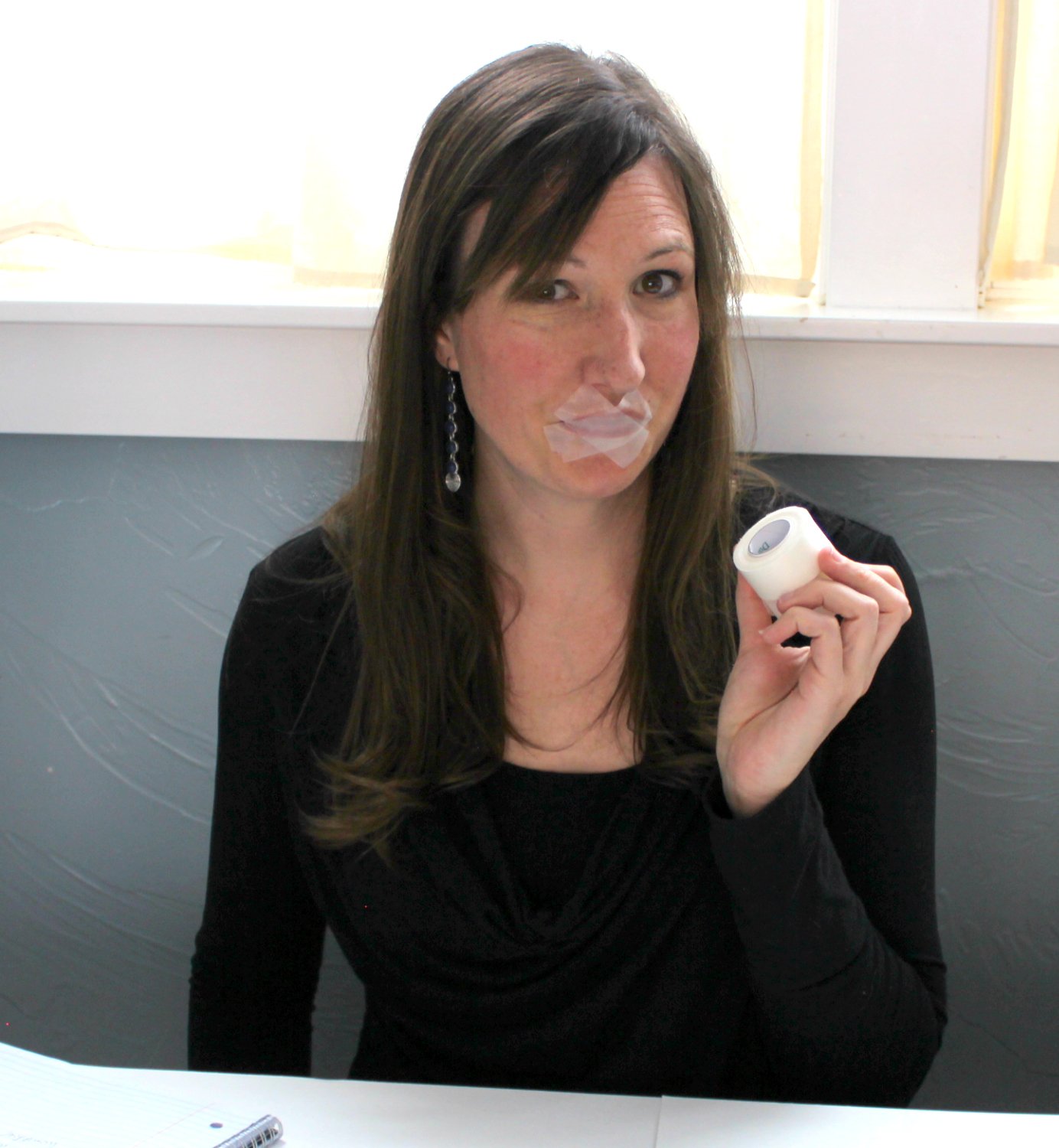
Stories of Mouth Taping:
- Just Take a Bite talks about taping her adorable daughter’s mouth, among other things to encourage nose breathing, to widen the palate, heal adrenals, reduce picky eating, and increase attention during the day.
- Beverly Meyer, of On Diet and Health, tapes her mouth for deeper sleep, less snoring, for asthma and allergies, for a more calm mind and body, and to increase nitric oxide production.
- Alex Fergus tapes his mouth closed for deeper sleep and to prevent dry mouth associated with mouth breathing.
- My friend Teresa (a fellow GAPS mom who is now doing keto too!) tried mouth taping when I started, and she also is excited about the changes. – see our convo below
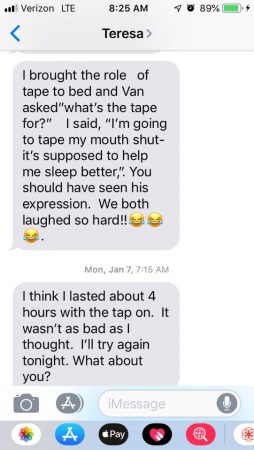

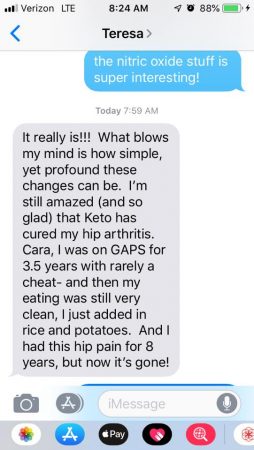
Sources:
https://www.ncbi.nlm.nih.gov/pubmed/28244881
https://www.sciencedirect.com/science/article/pii/S0954611109000432
https://www.ncbi.nlm.nih.gov/pubmed/3141357
https://www.sciencedirect.com/science/article/pii/S0021755717300116
https://www.ncbi.nlm.nih.gov/pubmed/20824738
https://www.ncbi.nlm.nih.gov/pmc/articles/PMC4047298/
https://www.ncbi.nlm.nih.gov/pubmed/8971255
https://www.ncbi.nlm.nih.gov/pmc/articles/PMC5137939/
https://www.ncbi.nlm.nih.gov/pmc/articles/PMC3392338/
https://www.ncbi.nlm.nih.gov/pmc/articles/PMC4738928/
http://www.jneurosci.org/content/19/17/7640
https://www.ncbi.nlm.nih.gov/pubmed/28738377
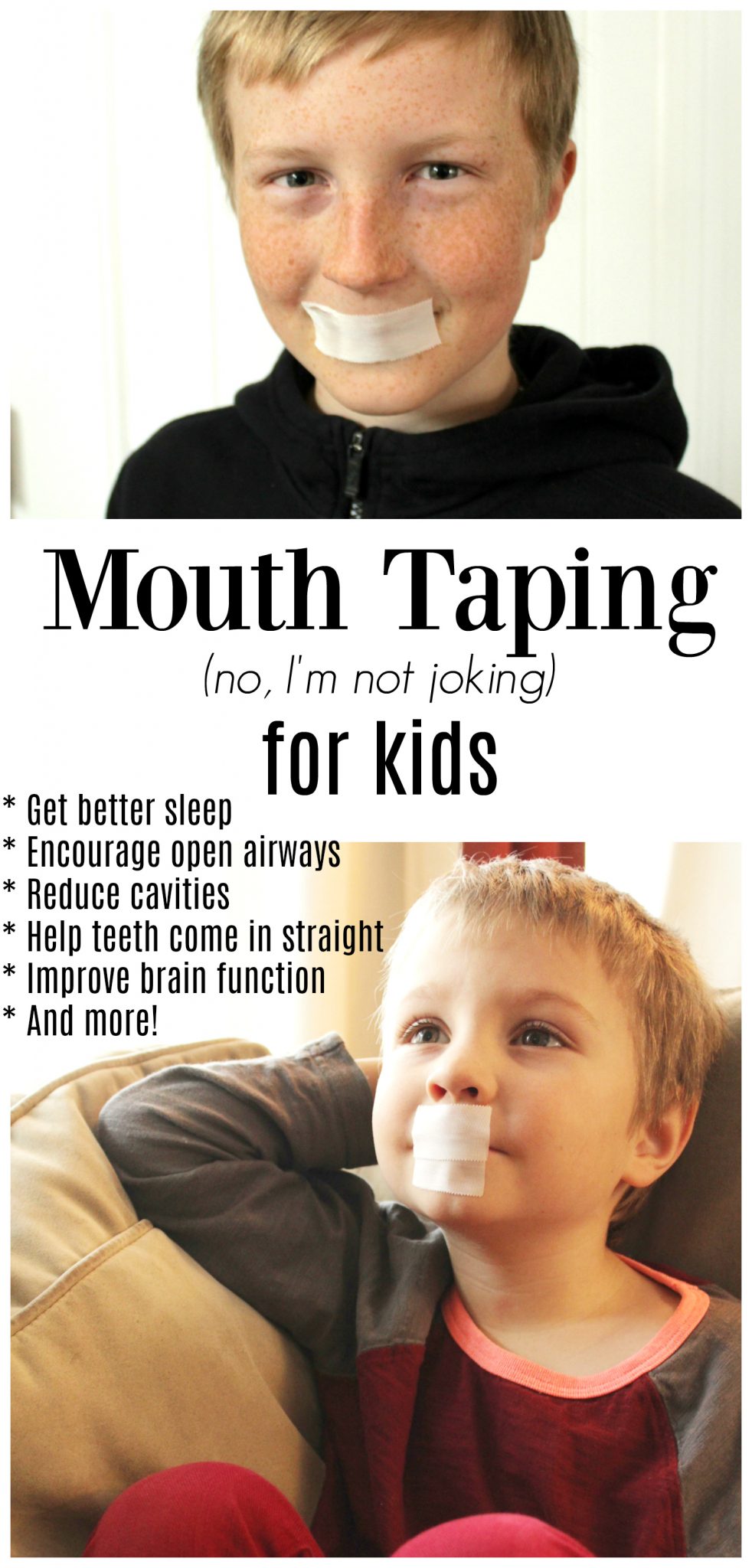
Learn how to heal leaky gut

60-page ebook of all my best GAPS Diet (Gut and Psychology Syndrome) articles all in one place.

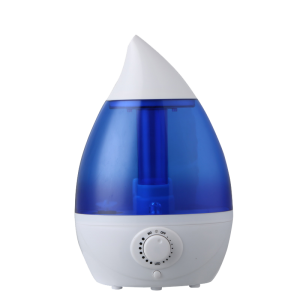


My 8 year old has a top front tooth that is behind his bottom teeth when he bites. He really needs this tape treatment. He will be getting a retainer to correct his bite this year. Should I wait until after his bite is corrected? Or would it be harmful to try the tape now?
Thanks for your opinion!
If it was my child, I’d start now! If he complains of jaw pain after you try it I’d stop and check with your dentist, but otherwise the body can correct quite a bit, especially as young as 8.
So interesting! All of my children sleep terribly, especially my 17 yo son with autism. But after I read this i thought, all 3 of them sleep with their mouths agape! I’m gonna talk them into trying this out… What could it hurt! Thank you so much for all your informative posts.
I’m not a mouth breather by day, but when I get horizontal I feel as though I’m going to suffocate when I keep my mouth shut. I read for an hour lying in bed before lights out; maybe I can try the tape while I’m awake so I can tell if I get cyanotic :). Thanks for your post. Ben Lynch’s book and talks are the first place I heard about needing to keep my mouth shut (well, except for my DH). And thanks for the tape tip–many tapes cause my skin to break out in red welts.
We’ve been doing this for 9 months now, as a family. The kids don’t love it, but they are used to it now and they are getting better about things. I’m always saying “Where’s your tongue?” of “Tongue on your spot!” We are seeing progress and praying for more as we continue.
Cara, do you know why we mouth breathe if our natural state is to breathe through our noses? Just curious. I have skeptical kids!
I understand! I think it might be from being ‘more allergic’ than healthier generations and having more chronically stuffy noses as children, so we lose the habit. We all start out nose breathing, as babies can breathe as they nurse/bottle feed for sure :) Also low-grade stress might have something to do with it too since we do naturally breathe through our mouths when stressed.
I struggle as an adult with mouth breathing and as I saw my son developing the habit because of his stuffy nose I realized why I do it too. I lived on Dimetapp in the 80’s when I was a kid, I was always stuffy. I also had asthma so breathing through my mouth was definitely a panic reaction to get air. I have times now as an adult where I start to panic when I make myself breathe through my nose because I feel positive that I am not getting enough air and not being able to breath is my worst fear. After discovering my son has a milk allergy I put a few things together about myself. When I was a kid I drank a lot of milk, I mean a lot. I would go through a gallon of whole milk by myself in two and a half days when I was as young as six. I connected the dots and realized my major stuffiness and need to drink Dimetapp daily had to come from my own allergy to milk. I still put half and half in my coffee but that is the only dairy I consume and my stuffy nose is cleared up. I do still have asthma and catch myself falling back on the old habit of mouth breathing but I am much more conscious of it. I am going to try mouth taping with my family, all three of my kids sleep terribly and are always tired and tend to breathe through their mouths. Thank you for this information!
I’m so glad you’re figuring out the milk allergy thing! It’s so common! I’d love to hear about how the mouth taping goes after you try it!
This sounds great but first you have to make sure there isnt a tongue tie first. That is one of the major causes of mouth breathing and no amount of taping your mouth will fix the tongue sitting in your mouth incorrectly.. All that will happen is you will get less oxygen because you cant even start to breath properly through your nose until the tie has beem fixed and you have done therapy to undo the damages. Please add this as a disclaimer..
That’s worth looking into, but my 3 all had tongue ties as infants (midline defect, I talked about it a little more here) and they all do just fine with tape. The little ‘tied’ bit stretched as they grew, it just made it so I had to nurse them in a certain position as newborns. They don’t look tongue tied now at 12, 10, and 4.
I think it’s good that people are aware of tongue tie, but I don’t think it’s quite as drastic as your comment implies.
You are completely misunderstanding the physiology behind this. Please encourage your followers to go to a speech pathologist for tongue thrust remediation. That is the only permanent appropriate solution. At rest a child or adult with a normal swallow will have their tongue rest on the alveolar ridge. You cannot mouth breath with your tongue in the correct resting posture. Please don’t tape your kid’s mouths.
We’ve been 10 years with a variety of SLPs at least once a week, sometimes 3x a week, in 3 different states. Taping helped correct open mouth posture within weeks. Please don’t assume that just because I DIY stuff I don’t also seek professional support, or that I need a master’s degree to help my children.
I am extremely concerned about your blog post about mouth taping. As a pediatric Speech-Language Pathologist with over 20 years of experience and a certification track orofacial myologist, the information you are giving to uninformed parents to TAPE their kids’ mouth closed is dangerous. Do you realize that children breathe through the mouth because the body makes them so THEY CAN LIVE? For 99% of children, this is NOT a choice, but survival. Do you know how to tell the difference?
I don’t see any information on your site regarding your extensive medical training enabling you to prescribe parents do this to their children. I also don’t see a disclaimer that you are NOT a medical professional. Don’t you think this should be posted over and over again?
I don’t have time to go into the other posts on your site, some of which are highly questionable as well, but this one is by far the most concerning with serious consequences should a parent decide tape the mouth of a child who CANNOT breathe through their nose due to a structural problem.
Please consider the ramifications of what you post especially since most people are not reading the entire post, nor seeking out medical professionals into why their children may be breathing with their mouths open.
Dr. Dawn M. Moore ClinScD., CCC-SLP
Clinical Doctorate in Speech-Language Pathology
Certification Track Orofacial Myologist
Owner/Founder
Expressions Speech, Language, & Myofunctional Center
No worries, I know I’ve hit something good when I start getting angry comments ;) I’ve had a dozen years of conflicting advice from certified professionals, it doesn’t rattle me anymore. It’s all over my blog that I’m just a mom, and nothing that I ever write can be considered medical advice.
I’ll make it quick for you and highlight other things that have worked for my child that you’d lose your sh*t over too so you can continue getting worked up about a family that you have never met that is helping their child:
* L-Carnosine for improved language development
* The GAPS Diet for better eye contact and improved language development
* The ketogenic diet for decreased processing time and better word recall
You are right,
The cause of respiratory diseases is mouth breathing. mouth breathing makes many problems for the respiratory tract. Therefore, the breath should be taken from the nose.
Thank you for your article and I find it super funny because I literally just bought the somnifix strips. I bought them to help keep my mouth closed while I use my CPAP because it goes on my nose and doesn’t work if you open your mouth. I definitely a lot better with the tape.
As far as doing this with my children, the question I am concerned about is why they mouth breather in the first place? Is it because their noses are stuffed up? If that’s the case, wouldn’t that make it very difficult to breathe? Couldn’t this cause issues or make them feel like they are suffocating? Wouldn’t we need to figure out a way to fix the stuffy nose problem first? For me, I have air blowing in my nose all night, which helps with getting more air through my nose. I deal with stuffiness as well, which makes it difficult to breathe through my mouth during the day. I’m just thinking we would have to deal with what causes the problem first, right?